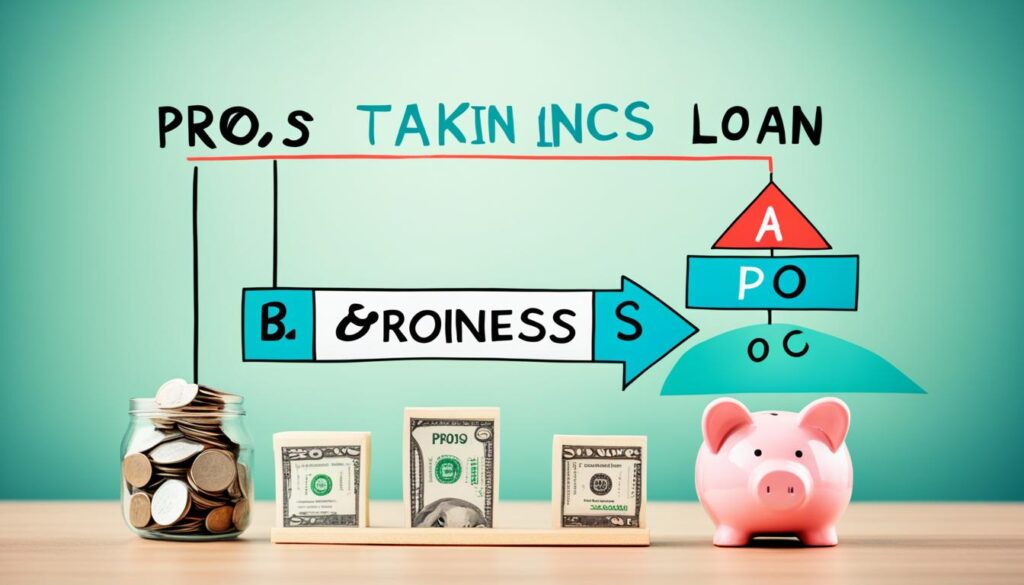Taking out a business loan can be a crucial step in growing a business, but it comes with both risks and benefits. It’s important for business owners to understand the potential risks, such as being in debt for a long time, high interest payments, collateral loss, giving up equity, personal asset risks, fees for missed payments, and damaging relationships with lenders. On the other hand, there are benefits, including access to funds, building business credit, and tax benefits.
Key Takeaways:
- Taking out a business loan carries risks such as being in debt for a long time, high interest payments, and collateral loss.
- Business loans provide access to funds, help build business credit, and offer tax benefits.
- Understanding the risks and benefits associated with business loans is crucial for making an informed decision.
Risks of Taking Out a Business Loan
When considering taking out a business loan, it’s important to be aware of the potential risks involved. Understanding these risks can help you make an informed decision and take necessary precautions to mitigate the negative impact they may have on your business.
Debt
One of the primary risks associated with taking out a business loan is the burden of long-term debt. Depending on the loan amount and repayment terms, you may find yourself in debt for an extended period. It’s essential to carefully analyze your business’s cash flow and financial projections to ensure that you can comfortably handle the loan repayments without jeopardizing your financial stability.
Interest Payments
High interest rates on business loans can significantly affect your profitability. Before committing to a loan, thoroughly evaluate the interest rates offered by different lenders and consider the impact they will have on your ability to make regular payments, reinvest in your business, and achieve your financial goals.
Collateral
Many lenders require collateral as security for the loan. Putting up collateral, such as property or valuable assets, carries the risk of losing them if you fail to meet the loan obligations. Carefully consider the value of the collateral you are risking and weigh it against the potential benefits of the loan.
Equity
Taking a loan from investors or venture capitalists may require giving up a percentage of equity in your business. While this can provide necessary funding, it also means relinquishing some control over decision-making and future profits. Carefully evaluate the terms and conditions before entering into any equity arrangement.
Personal Assets
Using personal loans for business purposes can put your personal assets at risk. If the business fails to meet its loan obligations, your personal savings, property, or other assets may be used to repay the debt. Consider the level of risk you are comfortable with and explore alternative financing options if necessary.
Missed Payments
Failure to make loan payments on time or defaulting on the loan can have severe consequences. You may face penalties, additional fees, damage to your credit score, and strained relationships with lenders. It’s essential to have a clear repayment plan and a solid strategy for handling potential financial challenges.
Lender Relationship
Building a positive and trustworthy relationship with your lender is crucial. Maintain open lines of communication and stay proactive in addressing any issues that may arise. Fostering a healthy lender relationship can help you navigate potential difficulties and find mutually beneficial solutions during the loan term.
While business loans can provide much-needed capital for growth and expansion, understanding the risks involved is essential. By carefully considering these risks, you can make an informed decision and take the necessary steps to mitigate potential challenges.
Risks of Getting a Business Loan

Getting a business loan can provide the necessary capital for growth and expansion, but it also comes with its own set of risks. It’s important for business owners to be aware of these risks and understand how they could impact their business in the long term.
1. Loan Payments
One of the obvious risks is the burden of loan payments. Taking on debt means committing to regular payments, which can strain cash flow and potentially lead to financial difficulties if not managed properly. It’s crucial to carefully evaluate the loan amount and repayment terms to ensure affordability.
2. Collateral
Many business loans require collateral as security for the lender. This collateral, which can be your business assets or personal assets, is at risk if loan payments are missed or default occurs. Losing valuable assets could have a significant impact on business operations and growth prospects.
3. Business Growth
Taking on a business loan can impact the ability to invest in business growth. Loan repayments may consume a significant portion of the business’s cash flow, leaving less available for crucial investments such as marketing, technology upgrades, or expanding to new markets. It’s important to weigh the potential growth opportunities against the loan’s impact.
4. Losing the Business
If a business fails to meet its loan obligations and defaults, there is a risk of losing the business altogether. Defaulting on a loan can lead to legal action, seizure of assets, and even bankruptcy. This underscores the importance of thorough financial analysis and diligent loan management.
5. Personal Guarantees
In some cases, lenders may require personal guarantees from business owners or directors. This means that if the business is unable to repay the loan, the personal assets of the guarantors can be used to satisfy the debt. Personal guarantees put individuals at personal financial risk and should be considered carefully.
6. High Interest Rates
Business loans often come with higher interest rates compared to personal loans or mortgages. High interest payments can significantly impact the overall cost of the loan and reduce the business’s profitability. It’s important to carefully consider the interest rate and its long-term impact on the business’s financial health.
7. Prepayment Penalty
Some loans may come with prepayment penalties if you decide to pay off the loan earlier than the agreed-upon term. These penalties can be substantial and should be factored into the loan decision-making process. It’s important to carefully review the terms and conditions to avoid unexpected financial burdens.
8. Financial Statements, Insurance, and Appraisal
When applying for a business loan, lenders often require detailed financial statements, insurance coverage, and appraisals of collateral. This can be time-consuming and add additional costs to the loan process. It’s important to gather and present these documents accurately and in a timely manner to avoid delays or potential rejection of the loan application.
While business loans can be a valuable tool for financing growth and expansion, the risks associated with borrowing should not be taken lightly. It’s essential for business owners to carefully assess their financial situation, the loan terms, and the potential impact on their business before making a decision.
Importance of Getting a Business Loan

When it comes to financing a business’s needs, getting a business loan can be of utmost importance. These loans provide access to the necessary funds that can be vital for various aspects of a business, such as starting, expanding, or sustaining its operations. With the additional capital obtained through a business loan, entrepreneurs can make strategic investments, hire more employees, purchase equipment, or develop new products and services.
One of the key benefits of getting a business loan is that it enables businesses to achieve their goals. Whether it’s launching a new product line, entering a new market, or expanding the existing customer base, a loan can provide the resources needed to turn these aspirations into reality. Moreover, a business loan can fuel financial growth by providing the necessary capital to seize market opportunities, stay ahead of competitors, and increase revenue.
It’s crucial for business owners to explore and evaluate different loan options available to meet their specific financing needs. This involves considering factors such as interest rates, repayment terms, and the level of flexibility offered by different lenders. By carefully examining these options, entrepreneurs can choose the loan that best aligns with their business goals and financial circumstances.
Getting Approval for a Business Loan
In order to secure approval for a business loan, it is crucial to have a strong business plan that clearly outlines the details and financial projections of your business. A well-developed and comprehensive business plan demonstrates your preparedness and commitment, making lenders more likely to consider your loan application favorably.
Another important step in the loan approval process is seeking pre-approval. Getting pre-approved for a loan gives you a clear understanding of your eligibility and the amount you can borrow. It also demonstrates to lenders that you are a serious and qualified candidate for a loan, increasing your chances of approval.
Lenders evaluate several factors when making lending decisions. Your credit history is a key consideration, as it provides insight into your financial responsibility and repayment behavior. Maintaining a good credit history by making payments on time and keeping your credit utilization low is essential.
Repayment terms are another important aspect that lenders examine. It is crucial to demonstrate your ability to meet the repayment obligations based on your cash flow projections and business income.
Collateral is often required for business loans, especially for larger loan amounts. Collateral acts as security for the loan and reduces the risk for the lender in case of default. Offering valuable assets as collateral increases the likelihood of loan approval.
Personal guarantees can also enhance your chances of loan approval. By providing personal guarantees, you assure the lender that you will repay the loan even if your business cannot.
Interest rates play a significant role in the affordability of the loan. A lower interest rate reduces the cost of borrowing and makes the loan more manageable for your business.
Some loans may carry prepayment penalties, which are charges incurred for paying off the loan earlier than the agreed-upon terms. It is essential to consider the potential impact of prepayment penalties on your overall borrowing cost.
Financial statements, such as profit and loss statements, balance sheets, and cash flow statements, provide a snapshot of your business’s financial health. Lenders use these statements to evaluate your ability to repay the loan and assess your business’s credibility.
Insurance is often required for certain types of business loans. Providing proof of adequate insurance coverage assures the lender that potential risks are mitigated.
In some cases, lenders may require an appraisal of the collateral offered. An appraisal helps determine the value of the assets and ensures that their worth aligns with the loan amount.
By considering these factors and ensuring that you have a strong business plan, good credit history, favorable repayment terms, collateral options, personal guarantees, competitive interest rates, appropriate financial statements, adequate insurance, and possible appraisals, you can increase your chances of getting approval for a business loan.
Consequences of Getting a Business Loan

When considering taking out a business loan, it’s crucial to understand the potential consequences that come along with it. These consequences can have a significant impact on your business and financial well-being. Let’s explore some of the key consequences and their implications.
Debt Repayment and Interest Payments
One of the primary consequences of getting a business loan is the responsibility of repaying the debt. You will need to make regular payments to the lender, which can place a strain on your cash flow. Additionally, interest payments add to the overall cost of the loan, affecting your profitability.
Credit Impact
When you take out a business loan, your creditworthiness comes into play. If you fail to make timely loan payments or default on the loan, it can have a negative impact on your credit score. This can make it more challenging to qualify for future loans or obtain favorable terms on other types of credit.
Collateral Loss
In some cases, lenders may require collateral to secure the loan. Putting up collateral, such as property or assets, increases the risk of losing those assets if you are unable to repay the loan. Losing valuable collateral can significantly impact your business operations and financial stability.
“Defaulting on a loan can lead to legal action and reputation damage.”
Legal Action
If you default on a business loan, the lender has the right to take legal action to recover the debt. This can result in additional costs, such as attorney fees, and may ultimately lead to financial distress or bankruptcy for your business.
Reputation Damage
Defaulting on a loan or facing legal action can also damage your business’s reputation. This can affect relationships with suppliers, investors, and customers, making it harder to secure future funding or maintain a positive image in the market.
In conclusion, the consequences of getting a business loan are significant and should not be taken lightly. It’s essential to carefully consider the potential risks and weigh them against the benefits before making a decision. Proper planning, responsible borrowing, and diligent repayment can help mitigate these consequences and ensure the long-term success of your business.
Ways to Reduce the Risks of Getting a Business Loan

When exploring the possibility of obtaining a business loan, it’s essential to consider the potential risks involved. However, there are strategies to minimize these risks and increase the chances of securing a loan that benefits your business.
- Establish a strong financial position: Before applying for a business loan, it’s crucial to ensure that your company is in a strong financial position. Lenders assess your financial stability and ability to repay the loan. Maintaining a healthy cash flow, reducing debt, and improving profitability can help demonstrate your company’s financial strength.
- Build creditworthiness: Lenders consider your credit history when evaluating loan applications. Establishing a solid credit history by making timely payments, managing debt responsibly, and resolving any issues can significantly enhance your creditworthiness. A higher credit score increases the likelihood of loan approval and may result in more favorable terms.
- Evaluate loan affordability: Carefully assess your business’s financial capabilities to determine the affordability of a loan. Consider factors such as existing debt obligations, monthly expenses, and projected cash flow. Calculating the loan’s impact on your business’s finances will help you make an informed decision and mitigate the risk of taking on excessive debt.
- Thoroughly evaluate collateral requirements: Collateral is often required to secure a business loan. Understand the specific collateral requirements and evaluate the potential risks associated with putting up valuable business assets. Carefully weigh the necessity of collateral against the risks it may entail.
- Negotiate favorable loan terms: Engage in an open dialogue with lenders to negotiate favorable loan terms. Discussing interest rates, repayment schedules, prepayment penalties, and other conditions can help reduce potential risks associated with the loan. Remember, lenders want to minimize their risks too, so negotiation can be a valuable tool in achieving mutually beneficial terms.
By implementing these proactive measures, you can reduce the risks associated with obtaining a business loan. Taking steps to establish a strong financial position, showcase creditworthiness, assess loan affordability, carefully evaluate collateral requirements, and negotiate favorable loan terms will increase the likelihood of securing a loan that aligns with your business’s goals and minimizes potential risks.
Comparison of Risk Reduction Strategies
| Strategies | Description |
|---|---|
| Establish a strong financial position | Ensure healthy cash flow, reduce debt, and improve profitability. |
| Build creditworthiness | Manage credit responsibly and maintain a good credit history. |
| Evaluate loan affordability | Assess the loan’s impact on the business’s financial health. |
| Thoroughly evaluate collateral requirements | Weigh the necessity of collateral against the risks it may entail. |
| Negotiate favorable loan terms | Discuss interest rates, repayment schedules, and other conditions. |
Comparing Risks and Benefits of Taking Out a Business Loan

When considering taking out a business loan, it’s essential to compare the risks and benefits. Making an informed decision involves conducting a thorough financial analysis and evaluating the total cost of the loan, ensuring it aligns with the business’s goals and risk tolerance.
A comprehensive financial analysis is crucial in understanding the potential risks and benefits of a business loan. This analysis involves examining the business’s current financial position, cash flow projections, and assessing the loan’s impact on profitability. By conducting a meticulous examination of the loan’s financial implications, businesses can make data-driven decisions and assess the overall feasibility of the loan.
Furthermore, evaluating the total cost of the loan is vital. This includes considering the interest rates, fees, and any hidden costs associated with the loan. By understanding the financial obligations associated with the loan, businesses can accurately assess their ability to make timely repayments and mitigate any potential financial strains.
Aligning the loan with the business’s goals is another critical factor in the decision-making process. Businesses should carefully evaluate whether the loan will contribute to their long-term growth objectives and assist in achieving their strategic milestones. This alignment ensures that the loan is utilized effectively and plays a crucial role in the business’s overall success.
Evaluating Risk Tolerance
Risk tolerance assessment is an integral part of considering the risks and benefits of a business loan. Businesses must objectively evaluate their risk tolerance and determine how much uncertainty they can handle. This assessment helps businesses determine whether the potential risks associated with the loan, such as financial obligations or collateral, align with their risk appetite.
By understanding their risk tolerance, businesses can make informed decisions regarding the level of risk they are willing to accept and undertake to achieve their goals. This assessment allows them to determine whether the benefits of the loan outweigh the potential risks and make a calculated and prudent decision about taking on additional debt.
Visualizing the Comparison
| Risks | Benefits |
|---|---|
| Debt and interest payments | Access to funds for business growth |
| Collateral requirement | Business credit building |
| Risk of losing personal assets | Tax benefits |
| Potential damage to lender relationship |
By comparing the potential risks and benefits of taking out a business loan, businesses can weigh the advantages and disadvantages and make an informed decision. It’s important to remember that not all risks and benefits apply universally and may vary based on individual business circumstances.
Pros and Cons of Business Loans

Business loans can provide valuable opportunities for businesses, but it’s important to weigh the pros and cons before making a decision. Here are some key factors to consider:
Pros of Business Loans
- Access to Funds: Business loans offer a reliable source of capital to fulfill various business needs, such as purchasing equipment, expanding operations, or investing in marketing.
- Business Credit Building: Regular repayment of business loans can help establish and improve a company’s credit profile, making it easier to secure future financing.
- Tax Benefits: In certain cases, the interest paid on business loans may be tax-deductible, resulting in potential savings for the business.
Cons of Business Loans
- High Interest Rates: Business loans often come with higher interest rates compared to other financing options, which can increase the overall cost of borrowing.
- Risk of Default: Failure to make timely loan repayments can lead to default, damaging the business’s credit and potentially resulting in legal consequences.
- Additional Debt: Taking on a business loan means adding another financial obligation to the business’s balance sheet, which can impact its financial flexibility.
It’s crucial for business owners to carefully evaluate the potential benefits and drawbacks of business loans. Assessing the specific financial needs, risk tolerance, and long-term goals of the business can help make an informed decision.
Types of Business Loans

When it comes to obtaining financing for your business, there are several types of business loans to consider. Each type of loan offers different financing options, interest rates, and loan terms to meet specific business needs. Understanding the various options can help you make an informed decision about the best loan for your company.
1. Commercial Loan
A commercial loan is a common type of business loan that is typically used to finance specific purposes, such as purchasing equipment or real estate, expanding operations, or funding working capital. Commercial loans often have fixed interest rates and set repayment terms. They can be secured by collateral or provided based on the business’s creditworthiness.
2. Business Line of Credit
A business line of credit provides businesses with a flexible borrowing option. It allows you to access funds as needed and repay them over time. Similar to a credit card, a business line of credit offers a pre-approved credit limit that can be utilized whenever funds are required. Interest is only paid on the amount borrowed, making it a convenient and cost-effective financing option.
3. Commercial Installment Loan
A commercial installment loan is designed for businesses that need to make specific purchases, such as new equipment or vehicles. These loans provide a lump sum of funds upfront, which is then repaid over a fixed term with regular installments. Commercial installment loans often have competitive interest rates and predictable repayment schedules.
By exploring these different types of business loans, you can find the financing option that aligns with your specific needs and goals. It’s important to consider factors such as interest rates, repayment terms, and financing options before making a decision.
| Loan Type | Financing Options | Interest Rates | Loan Terms |
|---|---|---|---|
| Commercial Loan | Various options based on specific business needs | Fixed interest rates | Set repayment terms |
| Business Line of Credit | Flexible borrowing as needed | Variable interest rates | Revolving access to funds |
| Commercial Installment Loan | Funds upfront for specific purchases | Competitive interest rates | Fixed repayment term with regular installments |
Factors to Consider when Applying for a Business Loan

When applying for a business loan, there are several important factors that entrepreneurs should take into consideration. These factors play a crucial role in determining loan approval and ensuring the financial stability and success of the business. By carefully evaluating these factors and addressing any potential concerns, applicants can increase their chances of securing the financing they need.
Credit History
One of the key factors that lenders consider when evaluating a business loan application is the credit history of the business and its owners. A strong credit history demonstrates responsible financial management and increases the likelihood of loan approval. It is important to review credit reports, address any errors or discrepancies, and work on improving credit scores before applying for a loan.
Loan Purpose
The purpose of the loan is another critical factor to consider. Lenders want to ensure that the funds will be used for a legitimate business purpose, such as expanding operations, purchasing equipment, or launching a new product. Applicants should clearly outline the purpose of the loan and provide supporting documentation to demonstrate how it will contribute to the growth and success of the business.
Loan Affordability
Applicants should carefully assess their business’s financial situation to determine the affordability of the loan. This involves evaluating the current cash flow, projected revenues, and expenses to ensure that the business will have sufficient funds to make timely loan repayments. Lenders often consider the debt-to-income ratio and the business’s ability to generate consistent revenue when assessing loan affordability.
Loan Terms
The terms of the loan, including the repayment period, interest rate, and fees, can significantly impact the overall cost and feasibility of the loan. It is important to carefully review and negotiate loan terms to ensure they align with the business’s financial goals and constraints. Comparing multiple loan offers and seeking expert advice can help in choosing the most favorable terms.
Financial Projections
Financial projections are essential in demonstrating the viability and potential profitability of the business. Lenders often require applicants to provide detailed financial projections, including sales forecasts, expense breakdowns, and cash flow projections. These projections should be realistic, based on thorough market research and a comprehensive understanding of the business’s industry and competition.
“By considering these factors, entrepreneurs can present a strong loan application and increase their chances of securing the financing they need to grow and succeed.”
When applying for a business loan, it is crucial to carefully consider factors such as credit history, loan purpose, loan affordability, loan terms, and financial projections. Taking the time to address these factors and present a well-prepared loan application can significantly improve the chances of approval and pave the way for business growth and success.
| Factor | Description |
|---|---|
| Credit History | The borrower’s credit history and the creditworthiness of the business |
| Loan Purpose | The intended use of the loan funds and how it aligns with the business’s goals |
| Loan Affordability | The business’s ability to comfortably repay the loan based on its financial position |
| Loan Terms | The specific terms of the loan, including repayment period, interest rate, and fees |
| Financial Projections | The realistic and well-supported projections for the business’s future financial performance |
Also Read : Your College Debt With Discover Student Loans Refinance
Conclusion
When considering whether to take out a business loan, it is essential to carefully assess the associated risks and benefits. By understanding the potential risks and benefits, entrepreneurs can make informed decisions regarding their loan options. Evaluating factors such as interest rates, repayment terms, and collateral requirements is crucial in determining the suitability of a loan for a business’s financial health.
While business loans provide access to funds for various purposes, it is important to weigh the benefits against the potential risks. Benefits include the ability to finance growth initiatives, build business credit, and leverage tax advantages. On the other hand, risks such as high interest rates, the possibility of default, and increased debt burden should be considered.
In summary, making a wise loan decision involves a thorough assessment of the potential risks and benefits. Entrepreneurs should carefully analyze their business’s financial health, goals, and risk tolerance when deciding to take out a business loan. By doing so, they can make informed choices that align with their business’s needs and trajectory.
FAQs
Q: What are the potential risks associated with taking out a small business loan?
A: Taking out a small business loan comes with risks such as high interest rates, potential impact on credit scores if payments are missed, and the risk of default which could lead to loss of collateral.
Q: How do business loans work?
A: Business loans work by a lender providing funds to a business which are then repaid over time with interest, typically in fixed monthly installments.
Q: What are the benefits of getting a term loan for business funding?
A: Term loans provide a lump sum of capital that can be used for various business needs such as expansion, inventory, equipment purchase, and more. They often have lower interest rates compared to other types of financing.
Q: How can I apply for a small business loan from the Small Business Administration (SBA)?
A: To apply for an SBA loan, you need to meet the specific requirements of the loan program you are interested in, complete the application process, and provide the necessary documentation as per the SBA guidelines.
Q: What are the differences between short-term and long-term business loans?
A: Short-term business loans have a shorter repayment period, usually less than a year, while long-term loans have longer repayment periods, often ranging from 3 to 25 years, depending on the type of loan.
Q: How do I find the best small business loan for my company?
A: To find the best small business loan, evaluate your business needs, compare different loan options from various lenders, consider the terms and interest rates, and choose the loan that aligns with your financial goals.
Q: What is the importance of collateral when applying for a business loan?
A: Collateral provides security for the lender in case the borrower defaults on the loan. It can help lower interest rates and increase the chances of approval, especially for borrowers with less-than-perfect credit.
Source Links
- https://fastercapital.com/content/What-Are-The-Risks-Of-Taking-Out-A-Business-Loan.html
- https://www.linkedin.com/pulse/pros-cons-taking-business-loan-mcdaccg
- https://midpennbank.com/loans-to-stimulate-small-business-growth/